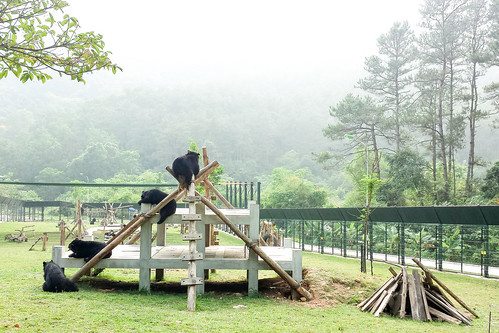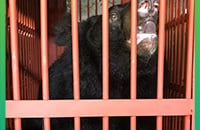Their job is to make 378 rescued bears happy – here’s how they do it
17 September 2015
Having survived hellish bile farms, rescued bears need protection and care – and our bear sanctuaries are set up to offer them just that.
Overseeing teams of more than 120 international and local staff in China and Vietnam, Bear and Vet Team Directors Nic Field and Annemarie Weegenaar share their insights with us.

Their list of tasks is long and varied but, put simply, their job is to make sad, terrified and sick bears – happy again.
China Bear and Vet Team Director Nic said:
“Essential to the idea of the ‘bear rescue centre’ is the rescue part of the equation. However the daily operations and long-term management of the bears that have suffered the traumas of bear bile farming is a lifetime process, encompassing a whole team that provides them with the opportunity to behave like bears again.
“At our centres, we try to give our bears the chance to just be bears again.”
Vietnam Bear and Vet Team Director Annemarie said:
“Bears on bile farms are generally kept in very small cages, in a non-stimulating environment where they endure tremendous suffering. Many of our bears arrive in deplorable physical and psychological condition, having endured years of pain and malnutrition. In China, surgery is often required to remove their infected gall bladders, and numerous other health concerns are addressed as well.”
But equally important is a decades long commitment to care for each bear.
Nic said:
“We take an integrative approach in our care for the bears. Both physical and psychological injuries are addressed through a holistic management strategy incorporating both behavioural and veterinary expertise. There are many things to consider in daily care – providing the bears with nutritious food and supplements, giving them preventative care, minimising their stress and checking on their moods, and promoting natural behaviour in their interactions with the other bears.
“One of the biggest preventative measures we use are comprehensive health checks every two to three years for all our bears – which equates to two to three health checks each week. And we are continuously training our staff to monitor the bears and detect changes from the norm. They in turn can inform our bear managers and veterinary team, who will flag a bear for special attention. This is the way a good system works, with everyone supporting each other.
“We also concentrate on their environment – through our comprehensive enrichment programme, key environmental stimuli which give our bears the chance to express their natural behaviour, which is essential for their physical and emotional well-being, and therefore for their welfare. We have dedicated horticultural teams at each centre, who are tasked with maintaining these semi-natural enclosures and ensuring our bears stay safe.”
Even something as seemingly automatic as feeding requires a good amount of expertise.
Nic continued:
“Bears are seasonal eaters and the amounts of food they’re offered have to be adjusted constantly. We also have to change the specific foods we offer depending on the season, keeping in mind the needs of the bears and the cost of the fruits and vegetables. This is all based on feedback from the Bear and Vet Teams, and personal observations.”
And of course, there is the thing that every other part of a sanctuary’s work relies on – putting a good team in place, and giving them the support they require to excel.
Annemarie said:
“At both sanctuaries our Bear and Vet Teams consist of several foreign veterinary and behavioural management professionals. They are employed for a minimum of two years and have come from far and wide – including the USA, UK, Australia, Netherlands, Hungary, Denmark, South Africa, Canada, and Norway, to name a few. Some have been with us for as long as nine years. They come to us with wide and varied experience and qualifications – having worked for sanctuaries, zoological facilities, and other charities across the globe.
“Whilst both sanctuaries benefit from these international melting pots of personalities and expertise, the majority of the Bear and Vet teams are locally employed. Capacity building is an integral part of Animals Asia’s work.
“Many of our locally employed team members have worked for the organisation since the sanctuaries were established and have played a key role in the development of both sanctuaries as they have evolved. And increasingly, locally employed staff are moving into more senior roles. They are perfectly positioned to be some of the best-received voices for animal welfare in their native countries.”
And that’s another vital part of the work that happens at Animals Asia’s bear rescue centres – giving our bear experts the opportunity to become more expert, and lead the way to a more humane tomorrow.
Nic said:
“Developing expertise, knowledge, and understanding of the impacts of bile farming on the bears is also crucial, and Animals Asia has enjoyed collaborations with international and national specialists in pathology, cardiology, ophthalmology, dentistry, and anaesthesia.
“By sharing their knowledge, our bear carers also contribute to animal welfare, behavioural, and veterinary workshops and conferences across Asia and the globe.”
Annemarie added:
“But the most important thing our sanctuaries do is provide a safe home for the rescued bears where they can live out their remaining years – a place where we can let our bears just be bears.”
BACK












 Freedom after two decades: Moon bears Nang and Mua rescued
Freedom after two decades: Moon bears Nang and Mua rescued
 With heavy hearts we say goodbye to our beloved Tulip
With heavy hearts we say goodbye to our beloved Tulip
 Three moon bears rescued from notorious bear bile farming hotspots in Vietnam
Three moon bears rescued from notorious bear bile farming hotspots in Vietnam